Embodied AI is redefining the boundaries of robotics by integrating physical form with intelligent systems, enabling machines to interact with the world more naturally and effectively.
Key Points at a Glance
- Embodied AI combines physical robots with artificial intelligence to create systems capable of natural interactions.
- These systems learn from their environment, using sensors and data to adapt and improve over time.
- Applications range from healthcare and education to autonomous vehicles and industrial automation.
- Researchers believe embodied AI could revolutionize human-robot collaboration in the near future.
Embodied AI, a cutting-edge field at the intersection of robotics and artificial intelligence, is transforming how machines interact with the world. Unlike traditional AI systems that operate solely in virtual environments, embodied AI integrates physical form with intelligence, allowing robots to perceive, learn, and act in real-world contexts.
This approach emphasizes the importance of physical presence and sensory interaction. Embodied AI systems use sensors, cameras, and other tools to gather data from their surroundings. By processing this data in real time, these robots can adapt to changing environments and respond naturally to human cues, bridging the gap between machines and people.
One of the most significant advantages of embodied AI is its ability to learn through experience. Instead of relying solely on preprogrammed instructions, these systems evolve by interacting with their environment, much like humans learn from trial and error. This capability is particularly valuable in applications requiring nuanced decision-making, such as healthcare, where robots assist in surgeries or provide support for patients with mobility challenges.
Embodied AI is also making strides in autonomous vehicles, enabling them to navigate complex environments with greater efficiency and safety. In industrial settings, robots equipped with embodied AI can collaborate with human workers, handling repetitive or dangerous tasks while enhancing productivity.
In education, embodied AI-powered robots are being used to teach social and cognitive skills, particularly for children with developmental disorders. These machines engage students in interactive learning experiences, fostering engagement and understanding in ways traditional methods cannot.
Despite its potential, embodied AI faces challenges, including the complexity of integrating physical hardware with advanced algorithms and ensuring ethical use of these technologies. Researchers are also working to address concerns about privacy and security as these systems collect and process vast amounts of data.
As embodied AI continues to evolve, it holds the promise of reshaping industries and improving the quality of human life. By combining physical presence with intelligent capabilities, embodied AI represents the next frontier in robotics, offering a glimpse into a future where machines are not just tools but collaborative partners in our daily lives.
